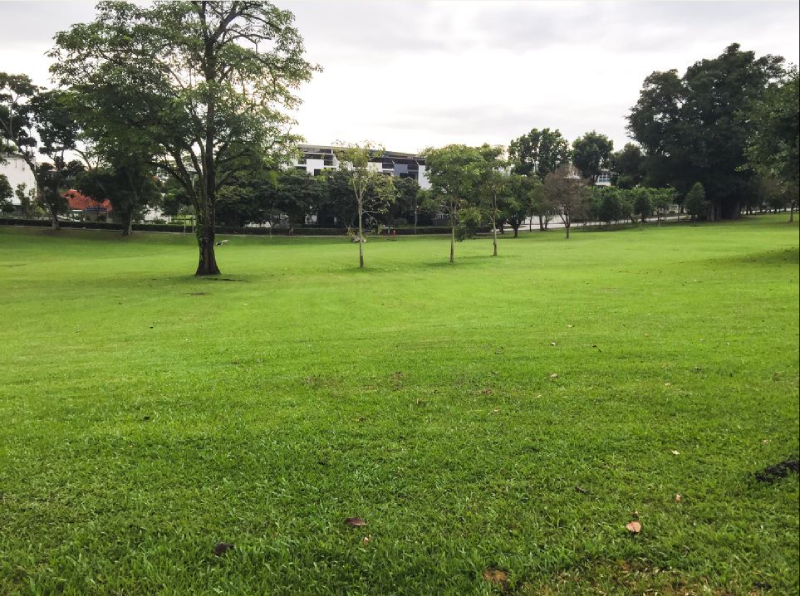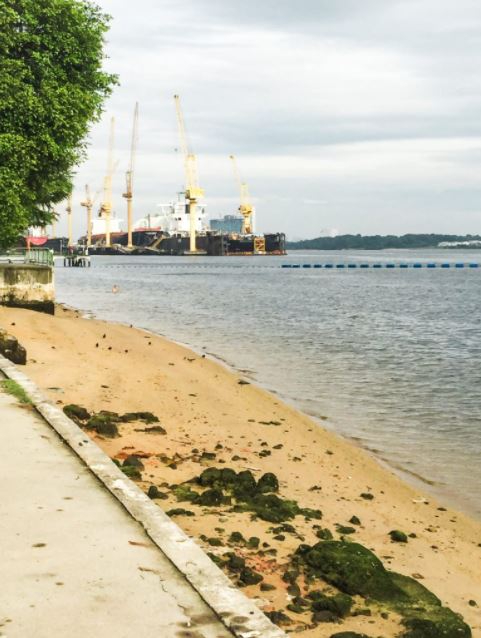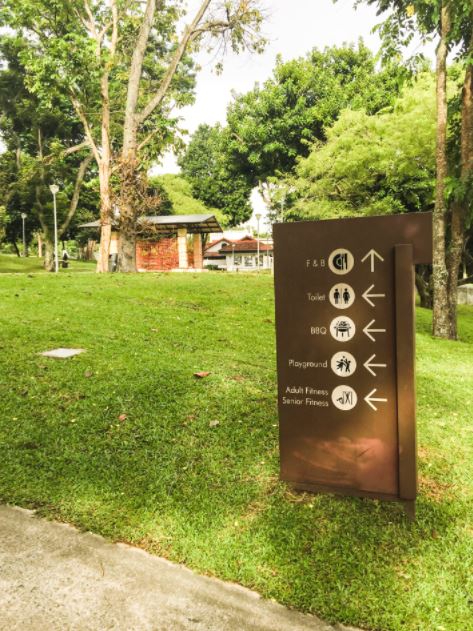Last week I set out to explore the waterfront country houses at Pasir Ris. In short, I came to the conclusion that they are close to nature, have a nice boardwalk, but are a bit crowded (at least the nearby beach and park are even at 7am on a weekday).
And while the prospect of living there appealed to me, the age of most of the houses (as the closer to the water are well in their 99 year leases) as well as the potential noise and pollution when vacationing in the chalets made me a little worried to be resumed.
I decided to explore other waterfront country houses before deciding whether or not to shortlist Pasir Ris in my search for a multigenerational home, so I went to Sembawang Park for another tour this week.
As I mentioned in a previous article, Canberra is a long way off. Sembawang, even further.
It took me about 40 minutes – and over 10 percent of my iPhone battery life using Google Maps – to get to Sembawang from central Singapore at 7am on a weekday (i.e. before rush hour).
I’ve been driving for so long that I wondered if I could get car sick from driving myself! However, when I got to Sembawang Park, I fell in love with the area. It felt like being transported back to old Singapore, to a time when it was not common to be crammed together like sardines.
While a few people were enjoying Sembawang Park and the beach, I saw an elderly couple practicing tai chi and one or two people fishing on the beach. The overwhelming feeling is of peace and serenity.
Yes, these words are often used in real estate ads, but this time around they are actually true. The loudest noise I could hear was the chirping of birds (note: there are no crowing roosters here, unlike Pasir Ris!), And not the cacophony of people screaming and screaming away.




Although the Sembawang Shipyard is currently adjacent to Sembawang Park (and the landed enclave), there was hardly any noise. It’s much more peaceful and much more beautiful than the West Coast Park.
(Also, Sembawang Shipyard will be relocating to Tuas by 2024, so hooray for the residents of the area! According to the URA site, the Sembawang Shipyard site “has the potential to become a mixed-use waterfront lifestyle neighborhood considering its rich maritime history “, which certainly sounds very exciting.)

I felt so relaxed and refreshed that it honestly felt like I was on vacation, a feeling I’ve missed for the past two years. In fact, we plan to come back next week!



- Sembawang is very close to Malaysia – from here you can literally see our neighbors! It is also very close to Pasir Gudang and the industrial areas of southern Malaysia, so pollution can be an issue. In 2012 someone said he could see a fire over in Pasir Gudang and, more importantly, smell it! when he was in Sembawang Park. If this happens rarely it wouldn’t stop me staying here, but I would love to personally experience how bad the fumes can be before I venture out.
At the time of writing, a number of homes in the area, some moving-in and some not, were for sale for $ 3 million and under, which you can find on 99.co and srx.com.sg.
I’m not going to list them all here, but noteworthy is a $ 2.8 million condominium bungalow which is a rarity in today’s market (note that it would likely require rebuilding and construction costs have increased due to Covid .) If you are on a tight budget, there is also a $ 2.6 million private terrace.
I’m particularly interested in Watercove, a freehold cluster house that is actually right on the ocean! (Unfortunately, the one unit currently for sale isn’t facing the sea.) I’d love to do an overall development review someday.
Before I finish this article, I thought it might be helpful to provide an overview of the maintenance costs associated with living in a country house. First things first, living in a GCB is obviously very different from living in a terraced house and the costs will therefore vary accordingly.
Since my series revolves around affordable waterfront living, I’ll only focus on row houses and semi-Ds. This Singsaver article has a table showing the maintenance costs of the different types of country houses.
However, after my research, the article seems to have grossly underestimated some numbers, especially those for bungalows and GCBs.
Some of the prime costs you can expect for smaller homes like terraces and semi-Ds include:
1. Roof repairs (or replacements) – Inevitable
Everyone I’ve spoken to who lives in a country house (be it a GCB or an inter-terrace) but one has had problems with the roof at some point.
(The only person who didn’t have any problems with the roof had an in-house contractor who came over every month to clean and maintain the roof, which probably not every homeowner can do!)
This can be anywhere from five to 20 years (please check with a roofer as it would really change on a case-by-case basis) and you will either need to do a roof maintenance or a complete roof replacement, which is not a cheap endeavor.
Don’t skimp on it, because that would literally be a penny, damn stupid: your roof could collapse on you, especially if it has rained very hard!
2. Painting – now and then
Every few years your home needs a coat of paint to keep it looking nice and clean. How often you choose to do this depends on how house trained you are. Keep in mind that oceanfront living is especially bad for buildings and waterfront properties need a special type of paint.
Some people I know actually save money by paying their helpers to paint their houses for them instead of hiring contractors! (You can also try it yourself if you’re a DIY enthusiast.) This could prove to be more expensive in the long run if your helper isn’t the capable type, so proceed with caution.
3. Gardener – Optional
You may or may not need a gardener depending on a few factors:
- Whether your land has a garden with soil (note that even if your land is 100 percent tiled, if you have potted plants like bamboo, they can fall off like crazy)
- How practical you want to be in the garden: I know people who live in semi-Ds with lots of green, but do all the gardening themselves while others have maximized their built-up area and still need professional help in the garden “!
- If you have extras, e.g. B. a fish pond, there are additional costs for maintenance
The cost varies widely: one friend does everything himself, another pays someone $ 50 per visit (the person is not a trained gardener!), Another pays a specialist $ 200 a week (and lets him come every week).
Note: You may be shocked to hear that cutting a tree in your own Singapore garden could be considered a criminal offense (i.e. fined) if the tree in question is a Grade I listed tree or if you live in one of two heritage areas in Singapore (Tanglin-Bukit Timah-Pasir Panjang and Changi)! So be careful!
4. Pest Control (e.g. Rentokil) – It’s up to you, but I highly recommend it
Pest control is like gardening. You may or may not pay for it, but if I were you I would.
All of the people I know who have saved up with this are either rat infested (it was no joke we caught over 20 of them!) Or termites. (If you have a large garden with lots of plants, you may want to get a mosquito fogging contract as well.)
5. Helper – Optional
Country houses are usually larger than apartments, so many families find that they cannot get along without helpers.
6. Refuse to pick up – If you can do without it, I’d love to hear now!
In 2016, country house garbage collection cost about $ 25 – more than three times the fee for apartments (which can be excluded from the system). It is also customary to give workers a gift of money during the festive season, such as Christmas or Chinese New Year.
7. Fence and Gate Maintenance Repairs – Inevitable
If your fence is made of metal (which won’t rust) rather than red brick, it can corrode and will need to be replaced. With gates, you have the choice between manual or electric – the latter is prone to breakdowns and can be painful information.
Additionally, seawater is terrible to metals and appliances (even the ones in your house), so you may have to replace things faster than normal if you live here.
8. Security – personal choice
Some people choose to install Chubb systems and cameras for security reasons.
9. Pool (if you have one) – Again, it’s your choice, but I recommend a professional
If your home has a pool, it would need to be cleaned weekly or biweekly. You could hire a professional or buy the chlorine and try to do it yourself: the person I know who tried the home improvement came over for a swim one day and found that the pool had turned green (algae) . Calculating the optimal amount of chlorine is apparently an art!
Note: I’ve heard from people that having a pool makes it easier to rent out a piece of land (the rental yield isn’t great for land in general).
As you can see, the maintenance of a property can be very flexible, so maintenance costs can vary widely from house to house. This is unlike a condominium, which has your MCST fees fixed.
Depending on how you want to live (and the level of upkeep your condo is on), you can potentially save quite a bit on upkeep by moving from a condo to a lot.
So if you are thinking of moving from an apartment to a house, I hope this has helped you better estimate the costs of living in a house. Next week – living by the water in Jalan Loyang Besar!
ALSO READ: Around Pasir Ris: Beachfront Country Homes Under $ 2.9M
This article was first published in Stackedhomes.

